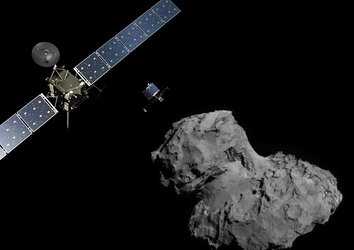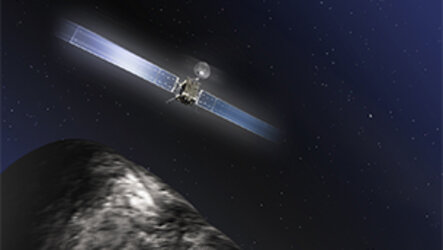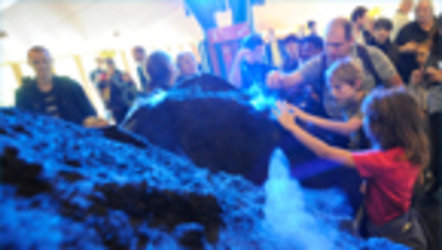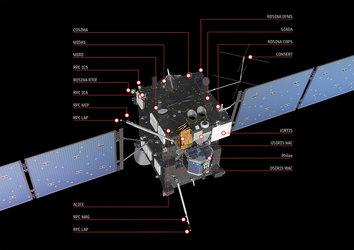Rosetta Media factsheet
Rosetta is the first mission designed to orbit and land on a comet. It consists of an orbiter, carrying 11 science experiments, and a lander, called ‘Philae’, carrying 10 additional instruments, for the most detailed study of a comet ever attempted.
Rosetta gets its name from the famous Rosetta stone that led to the deciphering of Egyptian hieroglyphics almost 200 years ago. Similarly, scientists hope that Rosetta will unlock the mysteries of how the Solar System evolved.
Rosetta’s launch was originally scheduled for January 2003 on an Ariane-5 rocket. Rosetta’s target at that time was Comet 46P/Wirtanen, with the encounter planned for 2011. However, following the failure of the first Ariane ECA rocket, in December 2002, ESA and Arianespace took the joint decision not to launch Rosetta during its January 2003 launch window. This meant that Rosetta’s intended mission to Comet 46P/Wirtanen had to be abandoned.
In May 2003, a new target comet and launch date for Rosetta were selected: the spacecraft was launched in March 2004 and will meet its new target, 67P/Churyumov-Gerasimenko, in 2014.
Objectives
ESA’s comet-chaser will be the first to undertake a lengthy exploration of a comet at close quarters. After entering orbit around Comet 67P/Churyumov-Gerasimenko in 2014, Rosetta will release its Philae small lander onto the icy nucleus.
Rosetta will orbit the comet for about a year as they head towards the Sun. Once they have passed perihelion (closest distance to the Sun), Rosetta will keep orbiting the comet for another half year, while the comet moves back out towards the orbit of Jupiter.
As the most primitive objects in the Solar System, comets carry essential information about our origins. Their chemical compositions have not changed much since their formation, therefore reflecting that of the Solar System when it was very young and still ‘unfinished’, more than 4600 million years ago. By orbiting Comet 67P/Churyumov-Gerasimenko and landing on it, Rosetta will allow us to reconstruct the history of our own neighbourhood in space.
Rosetta will also help to discover whether comets contributed to the beginnings of life on Earth. Comets are carriers of complex organic molecules, delivered to Earth through impacts, and perhaps played a role in the origin of life. Moreover, volatile light elements carried by comets may also have played an important role in forming Earth’s oceans and atmosphere.
During its long journey, Rosetta was scheduled to have two close encounters with asteroids of the main asteroid belt that lies between the orbits of Mars and Jupiter. The first was with (2867) Steins, a rare E-type asteroid. The flyby started on 4 August 2008 with optical navigation of the asteroid itself – a technique never before used in ESA spacecraft operations. The closest approach was on 5 September 2008, 18:58:19 UTC, when (2867) Steins was 2.14 AU from the Sun and 2.41 AU from Earth. The encounter occurred with a relative velocity of 8.62 km/s and reached a minimum distance of 802.6 km. The flyby took place on the Sun side of the asteroid in the plane defined by the relative velocity and the Sun direction. The flyby strategy allowed continuous observations of the asteroid before, during and after closest approach as well as passing through phase angle zero. To keep the asteroid in the field of view of the scientific instruments during the closest approach phase, the spacecraft had to target with an accuracy of better than 2 km and to perform an attitude flip manoeuvre lasting 20 minutes, after which autonomous tracking of the asteroid started.
On 10 July 2010 Rosetta had its second asteroid close encounter, this time with (21) Lutetia, a large asteroid (dimensions: 126 km x 103 km x 95 km – about 10 times bigger than Steins). The flyby was a spectacular success with Rosetta performing faultlessly, passing the asteroid at 15 km/s. The spacecraft had its closest approach at 15:44:57 UTC, at a distance of 3162 km. The cameras and other instruments had been working for hours and in some cases days before and after closest approach providing important new insights about the nature of this heavily cratered asteroid that has suffered many impacts during its 4.5 billion years of existence.
Cost
The total cost of the mission is 1.4 billion Euro of which the total Philae costs are 220 Million Euro. This includes the launch, the spacecraft, the science payload (instruments and lander) and mission and science operations.
Launch
Rosetta was launched on 2 March 2004 by an Ariane-5 from Europe’s Spaceport in Kourou, French Guiana.
Mission timeline
| Launch: | 2 March 2004 | |||
| 1st Earth swingby: | 4 March 2005 | (distance from Earth: 1955 km) | ||
| Mars swingby: | 25 February 2007 | (distance from Mars: 250 km) | ||
| 2nd Earth swingby: | 13 November 2007 | (distance from Earth: 5301 km) | ||
| Steins flyby: | 5 September 2008 | (distance from Steins: 802.6 km) | ||
| 3rd Earth swingby: | 13 November 2009 | (distance from Earth: 2480 km) | ||
| Lutetia flyby: | 10 July 2010 | (distance from Lutetia: 3162 km) | ||
| Enter deep space hibernation: | 8 June 2011 | |||
| Exit deep space hibernation: | 20 January 2014 | |||
| Comet rendezvous manoeuvres: | May - August 2014 | (distance from comet: 600,000–100,000km) | ||
| Arrival at comet: | 6 August 2014 | |||
| Philae lander delivery: | November 2014 | (distance from comet: 3 km) | ||
| Comet escort phase: | From Dec 2014 | |||
| End of mission: | December 2015 |
Planned mission lifetime
Rosetta’s mission will last for almost 12 years – until December 2015.
Spacecraft
Design
Rosetta resembles a large black box. The scientific instruments are mounted on the top of the box (the payload support module), while the subsystems are on the ‘base’ (bus support module). On one side of the orbiter is the steerable 2.2 m-diameter communications dish, while the lander is attached to the opposite face. Two enormous solar wings extend from the other sides. Both panels can be rotated through ±180° to catch the maximum amount of sunlight.
Mass
Approximately 3000 kg (fully fuelled) including 1670 kg propellant, 165 kg scientific payload for the orbiter, and the lander weighs about 100 kg.
Dimensions
The main spacecraft is 2.8 x 2.1 x 2.0 m, on which all subsystems and payload equipment are mounted. Two 14 m-long solar panels with a total area of 64 m2 provide electrical power.
Industrial involvement
Prime contractor was Astrium GmbH, Friedrichshafen, Germany, the leader of an industrial team involving more than 50 contractors from 14 European countries and the United States. Canada also participated in the construction of ESA’s first 35 m-diameter Deep Space Antenna in Australia, which was built for Rosetta. Throughout Europe, about 1000 people were involved in the development of Rosetta.
What’s on board?
Rosetta orbiter
The orbiter's scientific payload includes 11 experiments, in addition to the lander. Scientific consortia from institutes across Europe and the United States provided these state-of-the-art instruments.
Ultraviolet Imaging Spectrometer - ALICE will analyse gases in the coma and tail and measure the comet’s production rates of water and carbon monoxide and dioxide. It will provide information on the surface composition of the nucleus.
Principal Investigator: Alan Stern, Southwest Research Institute, Boulder, Colorado, USA.
Comet Nucleus Sounding Experiment - CONSERT will probe the comet’s interior by studying radio waves reflected and scattered by the nucleus.
Principal Investigator: Wlodek Kofman, Institut de Planétologie et d'Astrophysique de Grenoble, Grenoble, France.
Cometary Secondary Ion Mass Analyser - COSIMA will analyse the characteristics of dust grains emitted by the comet, such as their composition and whether they are organic or inorganic. Principal Investigator: Martin Hilchenbach, Max-Planck-Institut für Sonnensystemforschung, Katlenburg-Lindau, Germany.
Grain Impact Analyser and Dust Accumulator – GIADA will measure the number, mass, momentum and velocity distribution of dust grains coming from the cometary nucleus and other directions (deflected by solar radiation pressure).
Principal Investigator: Alessandra Rotundi, Università degli Studi di Napoli "Parthenope", Naples, Italy.
Micro-Imaging Dust Analysis System - MIDAS will study the dust around the comet. It will provide information on particle population, size, volume and shape.
Principal Investigator: Mark Bentley, Institut für Weltraumforschung, Graz, Austria.
Microwave Instrument for the Rosetta Orbiter - MIRO will determine the abundances of major gases, the surface outgassing rate and the nucleus subsurface temperature.
Principal Investigator: Samuel Gulkis, Jet Propulsion Laboratory, Pasadena, California, USA.
Optical, Spectrocopic and Infrared Remote Imaging System - OSIRIS has a wide-angle camera and narrow-angle camera that can obtain high-resolution images of the comet’s nucleus. Principal Investigator: Holger Sierks, Max-Planck-Institut für Sonnensystemforschung, Katlenburg-Lindau, Germany.
Rosetta Orbiter Spectrometer for Ion and Neutral Analysis - ROSINA will determine the composition of the comet’s atmosphere and ionosphere, the velocities of electrified gas particles and reactions in which they take part.
Principal Investigator: Kathrin Altwegg, Universität Bern, Switzerland.
Rosetta Plasma Consortium - RPC will measure the physical properties of the nucleus, examine the structure of the inner coma, monitor cometary activity, and study the comet’s interaction with the solar wind.
Principal Investigators: Hans Nilsson, Institutet för rymdfysik, Kiruna, Sweden; James Burch, Southwest Research Institute, San Antonio, Texas, USA; Anders Eriksson, Institutet för rymdfysik, Uppsala, Sweden; Karl-Heinz Glassmeier, Technische Universität, Braunschweig, Germany; Jean-Pierre Lebreton, Laboratoire de Physique et Chimie de l'Environnement et de l'Espace, Orléans, France ; Christopher Carr, Imperial College of Science, Technology and Medicine, London, United Kingdom.
Radio Science Investigation - RSI will, by using shifts in the spacecraft’s radio signals, measure the mass, density and gravity of the nucleus, define the comet’s orbit, and study the inner coma.
Principal Investigator: Martin Pätzold, Universität zu Köln, Cologne, Germany.
Visible and Infrared Mapping Spectrometer - VIRTIS will map and study the nature of the solids and the temperature on the surface. It will also identify comet gases, characterise the physical conditions of the coma and help to identify the best landing sites.
Principal Investigator: Fabrizio Capaccioni, Istituto di Astrofisica e Planetologia Spaziali, Rome, Italy.
Philae lander
Design
The lander’s structure consists of a baseplate, an instrument platform and a polygonal sandwich construction, all made of carbon fibre. Some of the instruments and subsystems are beneath a hood covered by solar cells. An antenna transmits data from the surface to Earth via the orbiter. The lander carries nine experiments, with a total mass of about 21 kg. A drill will sample the subsurface material.
Alpha Proton X-ray Spectrometer - APXS. Lowered to within 4 cm of the ground, APXS will detect alpha particles and X-rays to gather information on the elemental composition of the comet’s surface.
Principal Investigator: Göstar Klingelhöfer, Johannes Gutenberg-Universität, Mainz, Germany.
Rosetta Lander Imaging System- ÇIVA/ROLIS is a CCD camera that will obtain high-resolution images during descent and stereo panoramic images of areas sampled by other instruments. Six identical micro-cameras will take panoramic pictures of the surface. A spectrometer will study the composition, texture and albedo (reflectivity) of samples collected from the surface.
Principal Investigators: Jean-Pierre Bibring, Institut d'Astrophysique Spatiale, Université Paris Sud, Orsay, France; Stefano Mottola, Deutsches Zentrum für Luft- und Raumfahrt, Berlin, Germany.
Comet Nucleus Sounding - CONSERT will probe the internal structure of the nucleus. Radio waves from CONSERT will travel through the nucleus and will be returned by a transponder on the lander.
Principal Investigator: Wlodek Kofman, Institut de Planétologie et d'Astrophysique de Grenoble, Grenoble, France.
Cometary Sampling and Composition experiment - COSAC is one of two ‘evolved gas analysers’. It will detect and identify complex organic molecules from their elemental and molecular composition. Principal Investigator: Fred Goesmann, Max-Planck-Institut für Sonnensystemforschung, Katlenburg-Lindau, Germany.
Evolved Gas Analyser - MODULUS PTOLEMY is another evolved gas analyser that will obtain accurate measurements of isotopic ratios of light elements.
Principal Investigator: Ian Wright, Open University, Milton Keynes, UK.
Multi-Purpose Sensor for Surface and Subsurface Science - Mupus will use sensors on the lander’s anchor, probe and exterior to measure the density, thermal and mechanical properties of the surface.
Principal Investigator: Tilman Spohn, Institut für Planetenforschung, Deutsches Zentrum für Luft- und Raumfahrt, Berlin, Germany.
Rosetta Lander Magnetometer and Plasma Monitor - Romap is a magnetometer and plasma monitor that will study the local magnetic field and the interaction between the comet and the solar wind.
Principal Investigators: Hans-Ulrich Auster, Technische Universität, Braunschweig, Germany; István Apáthy, KFKI, Budapest, Hungary.
Sample and Distribution Device - SD2 will drill more than 20 cm into the surface, collect samples and deliver them to different ovens or for microscope inspection.
Principal Investigator: Amalia Ercoli-Finzi, Politecnico di Milano, Milan, Italy.
Surface Electrical, Seismic and Acoustic Monitoring Experimens - SESAME's three instruments will measure properties of the comet’s outer layers. The Cometary Acoustic Sounding Surface Experiment will measure the way sound travels through the surface. The Permittivity Probe will investigate its electrical characteristics, and the Dust Impact Monitor will measure dust falling back to the surface.
Principal Investigators: Klaus Seidensticker, Deutsches Zentrum für Luft- und Raumfahrt, Cologne, Germany; István Apáthy, KFKI, Budapest, Hungary.
Operations
Mission Operations Centre: European Space Operations Centre (ESOC), Darmstadt, Germany.
Prime Ground Station: ESA Deep Space Antenna in New Norcia, near Perth, Australia.
Rosetta Science Operations Centre: European Space Astronomy Centre (ESAC), in Villafranca, Spain.
Lander Control Centre: DLR, Cologne, Germany.
Lander Science Centre: CNES, Toulouse, France.
ESA Mission Manager: Fred Jansen
ESA Project Scientist: Matt Taylor
ESA Spacecraft Operations Manager: Andrea Accomazzo
More information about ESA’s Rosetta mission at: www.esa.int/rosetta
General information about ESA’s Space Science missions can be found at: www.esa.int/science
For further information
ESA Media Relations Office
Tel: +33 1 53 69 72 99
Fax: +33 1 53 69 76 90
Email: media@esa.int







